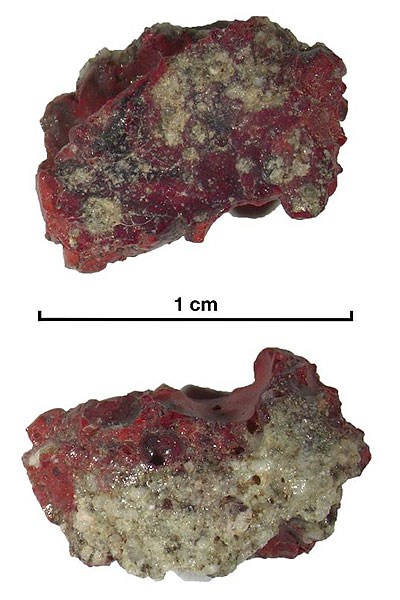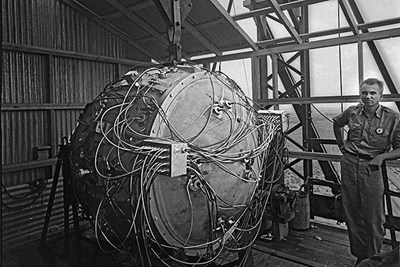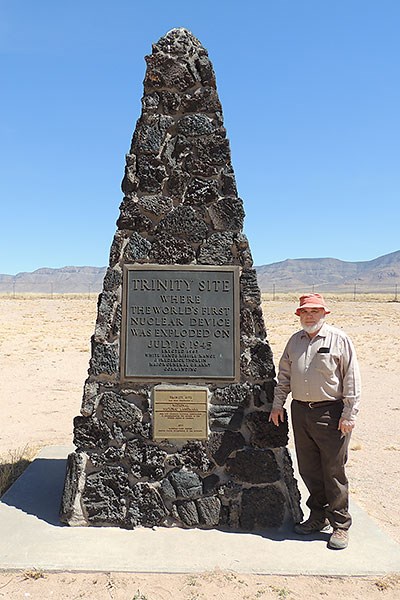UMass Lowell researchers discover new quasicrystal in atomic rock
Material left over from world's first atomic explosion

A recent discovery by a research team that includes Kennedy College of Sciences Prof. Nelson Eby is shedding light on the debris created by an atomic blast, and it could set the stage for advances in materials research, including potential applications in energy, health care and nuclear forensics.
The team, which also included researchers from the University of Florence in Italy, the California Institute of Technology, Los Alamos National Laboratory, Princeton University and the University of Maryland, discovered a new quasicrystal in a trinitite sample it investigated.
“Trinitite, which is also known as atomic rock, is a glassy material that was first produced by the extreme heat and pressure of an atomic explosion during World War II,” says Eby, who is with the Department of Environmental, Earth and Atmospheric Sciences.
“Quasicrystals are strange crystalline forms that do not follow the normal laws of crystal symmetry,” he explains. Quasicrystals were first identified in the early 1980s in an aluminum-manganese alloy. Since then, laboratory experiments have produced a variety of quasicrystal structures.

“Naturally occurring quasicrystals have been found in meteorites and meteorite impact structures,” Eby says. “And most recently, in the debris associated with an atomic detonation, which is the focus of our research.”
A greater understanding of the conditions under which various types of quasicrystals form can be used to design quasicrystals for specific purposes, he says.
“Quasicrystals are not currently used in industrial applications, but some suggested uses include heat insulation, new materials that convert heat to electricity, bone repair and prosthesis applications,” he says.
The team’s findings were presented in a research paper titled, “Accidental Synthesis of a Previously Unknown Quasicrystal in the First Atomic Bomb Test,” which was published in May in the Proceedings of the National Academy of Sciences.
According to Eby, the study of trinitite is important since it serves as a vital tool in nuclear forensic investigations.
“Because of concerns about the proliferation and possible use of atomic weapons by rogue nations and terrorist groups, over the past decade forensic studies of radioactive elements contained in trinitite have been conducted by a number of academic and federal laboratories and institutions, including UMass Lowell,” he says.
“For example, materials recovered from a detonated atomic device would most likely contain remnants of the bomb, and knowing the relationship between glass chemistry and radioactive elements in the materials would be useful in characterizing the device and ultimately identifying the perpetrators.”
Code Name: Trinity
On July 16, 1945, the United States military detonated history’s first atomic bomb, a plutonium device dubbed “Gadget,” at a remote site in southern New Mexico. The mission, which was part of the top-secret Manhattan Project, was to test this prototype of a new breed of weapons that were to be used against Japan to force its surrender in World War II.

The test, code-named “Trinity,” went off as planned, with the device detonating and producing a blast equivalent to 21,000 tons of high explosives (TNT). Heat from the resulting fireball caused the 100-foot steel tower holding Gadget to vaporize instantly. The surrounding desert sand was also melted into a layer of green, glassy material, which was later called trinitite in honor of the test’s name.
Much of the material and debris was sucked into the fireball’s rising mushroom cloud of hot gases. As this material was transported downwind by the gas cloud, molten droplets of glass rained down onto the ground over a wide area.
“Contained within the glass are melted bits of the device and its support structures and various radionuclides formed during the blast,” says Eby.
After three-quarters of a century, trinitite is still slightly radioactive but is relatively safe to handle, he notes.
Trinitite-like materials were also found in other U.S. atomic tests that followed after the war.
Blood-red Trinitite
The majority of trinitite is pale green in color, but the material that the team investigated has a rare, blood-red color due to copper that melted with the desert sand. The copper came from miles of data transmission lines that connected Gadget and the tower to recording instruments.
The material, which was provided by team member William Kolb, is among the samples collected in late 1945 by a meteorite researcher north of the blast site. In it, the scientists discovered a new quasicrystal shaped in an icosahedron (a solid, 3D structure with 20 faces) and composed of silicon, copper, calcium and iron.

This red trinitite quasicrystal represents the oldest such material made by humans that is currently known, and whose origin is well documented from historical records of the Trinity test, according to Italian geologist and professor Luca Bindi, who is the paper’s lead author. Bindi conducted studies on the sample using a scanning electron microscope and electron microprobe, and single-crystal X-ray diffraction techniques.
“The tremendous pressure and temperature generated by an atomic detonation can lead to new forms of quasicrystals, such as the one we identified and described in our paper, that cannot be produced in a laboratory,” says Eby.
The Expanding Field of Nuclear Forensics
“At UMass Lowell, my student researchers and I have been studying the complex chemistry of the trinitite glasses and the distribution of radioactive elements throughout the glasses,” Eby says. “Our research has shown that certain glass chemistries are more likely to contain radioactive material, which could reflect the nature of the atomic blast. And this data is very helpful in nuclear forensics.”
Eby says in any ground-level atomic explosion, glassy materials similar to trinitite will be formed.
“We can therefore use the chemical signatures and radioactivity of these glasses to identify the type of atomic device that was detonated and to estimate its ‘yield,’ or explosive power,” he says. “Also, this knowledge is important for assessing the potential release of radioactive materials into the environment.”
Such a forensic technique is useful, especially in the face of growing terrorist threats from so-called “suitcase bombs.”
“Fortunately, since the end of World War II, an atomic device has not been used against civilian or military targets. However, should this happen – hopefully never – nuclear forensics ultimately could help us identify the bomb and the bomb makers,” says Eby.